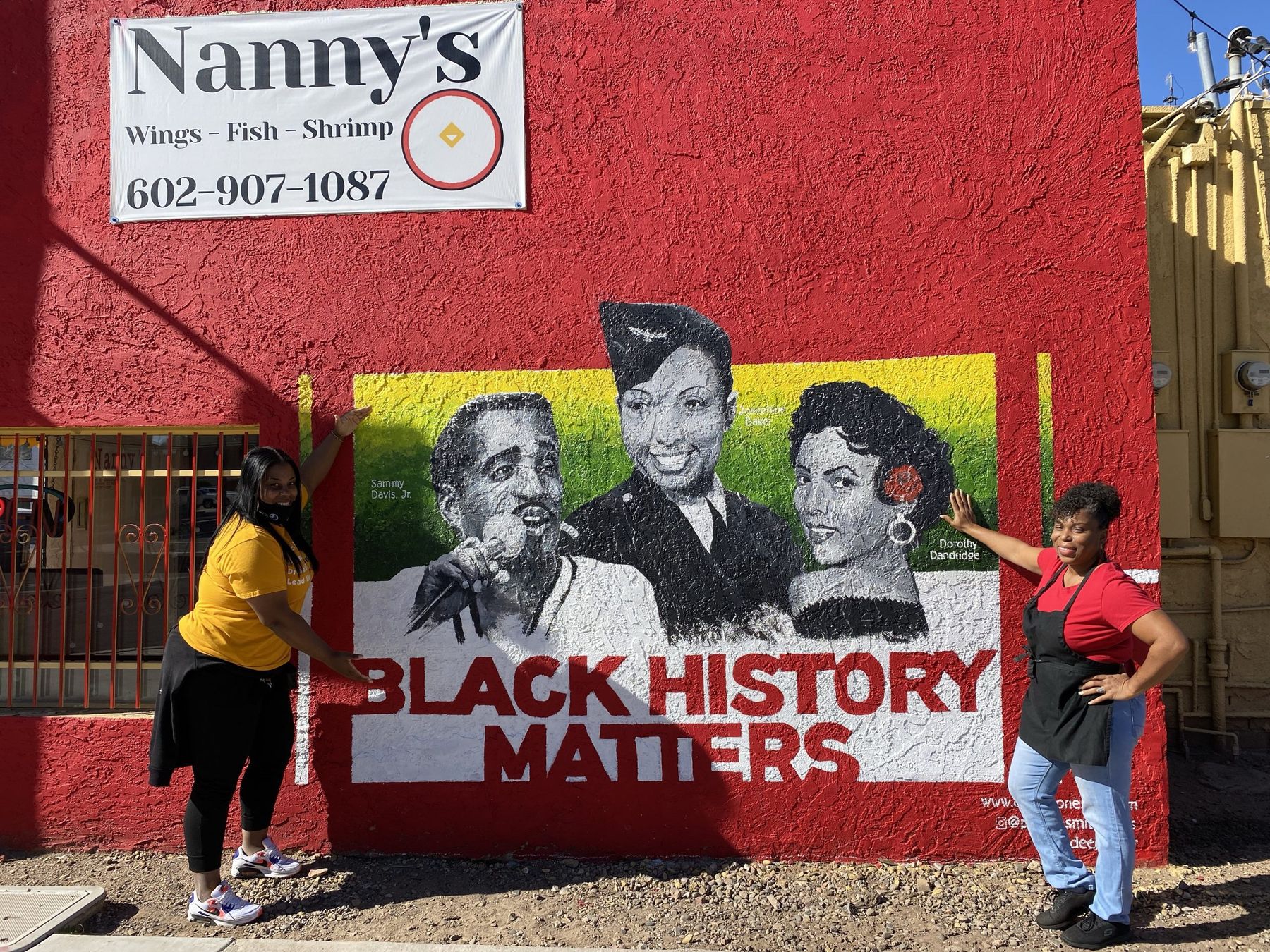A Dream Come True: 28 Murals Painted Across Phoenix to Celebrate Black History Month for Second Year
As you drive down Washington Street into Downtown Phoenix, it’s hard to miss the bright mural painted on the side of Nanny’s Fried Chicken on Ninth Street.
The mural features portraits of Sammy Davis Jr., Josephine Baker and Dorothy Dandridge — three iconic entertainers and Black history makers.

Painted by artist Debra Jones, it’s just one of 28 murals being painted in central Phoenix for the second year in a row. The project honors hundreds of influential Black pioneers, educates, and brings awareness to many faces and names you may not know.
The effort is part of the Black History Mural Project founded by Gizette Knight of the Shining Light Foundation, launched last year.
“To be a part of this project is a dream come true for me,” said Andrea Nabors, co-owner or Nanny’s. “I feel like our mural is a great statement piece for us. As Black business owners, I’m proud to have it on the building and proud to represent something for our Black community.”
Nabors plans to post a small biography of each entertainer depicted in the mural inside the restaurant so customers can learn more about each icon.

“People need to know about our history because when you look at the people in power, it’s not us. So they need to know about our history, they need to know about why we’re so valuable,” Knight said. “When we shout out Black lives matter it’s because we matter, we contribute significantly to this country and a lot of these luxuries people take for granted and they don’t even know about.”
Pioneers like Charles Drew, who invented a way to process and preserve blood plasma, Frederick Jones, who invented the first automatic refrigeration system for trucks, and Otis Boykin, who invented the pacemaker, are just a few of the prominent figures featured in murals this year.
‘I see the need for change’
The Black History Mural Project has expanded outside of Phoenix, to cities including Dallas, Los Angeles and Atlanta, according to Knight, who has a goal of painting 365 murals across the country by 2024.

Knight said she’s also partnering with local school districts to write essays on each figure, which will be attached to each mural via QR code.
“I see the need for change and I’m bringing some of that with these murals downtown to educate people and to help bring value within our kids so they can see representation,” Knight said. “So they can say, ‘maybe I could be a doctor,’ ‘maybe I could be a scientist, an inventor, a pilot.’”
A mural dedicated to Dr. Sian Proctor is in the works, who was the first African American woman to pilot a spacecraft, and is now a professor at South Mountain Community College.
The Artists behind the murals
This year, more than 22 artists of all backgrounds came together to make the project happen. Artists include Maria Madrid Reed’s mural of Madam CJ Walker, Mary Ellen Pleasant, and O.W. Gurley near Eighth and Washington streets.

Giovannie “Just” Dixon was commissioned to complete three of the 28 murals, two of which are located on the corner of Second and Lincoln streets. Artist David Morgan’s mural is located on the Western side of Mrs. White’s Golden Rule Cafe at Eighth and Jefferson streets.
On February 1, a kickoff celebration of the project was held at Footprint Center. At the end of the event, a mural on the western side of the arena was unveiled featuring prominent Black athletes including Larry Fitzgerald and Brittney Griner. The mural was painted by Lucretia Torva and Jennifer White.
“I wanted to have to have a diverse amount of artists, Black artists, Indigenous artists, white artists. Each of these artists were encouraged to do research about the people that they were painting,” Knight said.
A documentary on last year’s mural project is scheduled for Friday, Feb. 11 at Luna Culture Lab. A panel discussion with the filmmakers, artists, and community leaders will follow the screening.
“We’re putting up figures that don’t get talked about,” said Knight.
“There’s a lack of acknowledgement about Black culture and what Black figures did in this country. We’re talking about Black figures and what they contributed to society.”